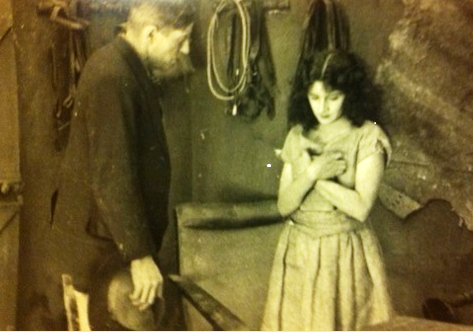The story of “Miss Ashwin, a ravishing green–eyed beauty with round shoulders as white as milk and a cloud of inky hair” is as much a tale of family history as it is of Queensland history and Australian cinema. When the request came in to research the history of an individual, Doris Ashwin, it shed light on a fascinating period in the much broader history of the Queensland silver screen.
In the early 1920s, an ambitious 24 year old returned from Hollywood, keen to apply his new found knowledge of film production to the backdrop of his native homeland. The result was “The Moth of Moonbi”, Queensland’s first feature length film, written, directed and produced by Charles Chauvel and starring Doris Ashwin and her soon-to-be husband, Thomas Marsden Hassell.

A scene from 'The Moth of Moonbi': leading actress Doris Ashwin with Marsden Hassell, 2911 Charles Chauvel and Elsa Chauvel Photographs and Papers 1911-1980s, John Oxley Library, State Library of Queensland, Neg: 175399. http://onesearch.slq.qld.gov.au/permalink/f/1oppkg1/slq_alma21148643950002061
At its first public screening in Queensland, in 1926, it opened to packed theatre audiences at the Wintergarden Theatre. The Queensland Times (Ipswich) reported that the audiences stood and applauded, thrilled to see the people whom they knew and the places around Harrisville that were familiar to them.
The plot revolves around Dell Ferris, a country girl from the town of Moonbi and Tom, a head stockman who loves her deeply. Regardless of this, she heads to the city where she leads a lavish and sophisticated life. Having soon depleted the small inheritance she received and realising the value of what she has left behind, Dell returns to Moonbi and marries Tom.
Mabel Forest, the author of the bestselling book “The Wild Moth” on which the film is based, said of the film, that it was like watching “her own brain children as it were, playing their part amongst the gum-scented solitudes” (Western Champion (Barcaldine) Saturday, 5 June 1926, p 19).
Background of an early film star: A woman of her time and place
Doris Ashwin is not a household name, and yet she is one of Queensland’s most significant film actors. In 1925 she was already a well-known theatre actress and had been working in theatre productions from the age of 10, including productions of J.C. Williamson.
Although she was reportedly selected from hundreds of applicants and all publicity shots for the film were of her, the ever modest Doris Ashwin claimed it was in fact her husband, Thomas who was the true star of the film.
Rather than pursue this celebrity, Doris Hassell nee Ashwin chose the highs and lows of family life, only occasionally disrupted by the odd reporter looking for a story on the once famous actress. She died in Brisbane in 1988 and is buried with her husband and fellow film star, Thomas Marsden Hassell in Toowong Cemetery. Had Doris chosen the bright lights of the film industry however, she may have enjoyed the same success as other Australians whose careers had been launched in Chauvel films such as Errol Flynn in the The Wake of the Bounty, and Chips Rafferty in Forty Thousand Horsemen.
A Queensland history story
The Moth of Moonbi was the first of two silent films Chauvel produced before the “talkies” hit Australia in 1930; the other being Greenhide. Both films are important social and cultural records of Queensland’s history and accurately capture the region as it was at the time.
As a director, Chauvel brought the valuable skills and Hollywood experience of a true cinematographer to Queensland. He produced content which showed Australians and Queenslanders in particular, in familiar settings such as Ipswich and Rockhampton, with an eye for detail that created a “complete Queensland atmosphere”. Audiences and reviewers revelled in the opportunity to reflect on who they were, and what role they played in developing Queensland culture. We, too, appreciate this accurate snapshot of Queensland life and history, with screenings of this iconic film still being shown in old Queensland picture theatres for film enthusiasts.
Queensland & Australian cinema resources at State Library of Queensland
Locate and search biographical resources including: birth, death, and marriage records, electoral rolls and newspaper extracts, to track the individual lives of Australian cinema figures.
Use our newspaper collection and Trove, to view accounts and reviews of films as well as news and pictures of the stars.
To find out about early films and filmmaking, use the catalogue, One Search to discover a diverse collection of material on Australian cinema, including biographies, histories, film making and other related topics with an abundance of visual material.
State Library is a listed access centre for the National Film and Sound Archive’s collection. This means that you can view material at State Library’s film viewing room on Level 2.
Head to the John Oxley Library on Level 4 to find specifically Queensland history including the Chauvel material: 2911 Charles Chauvel and Elsa Chauvel Photographs and Papers 1911-1980s.
Amanda Ladds
Librarian, Information Services
More Information
The Moth of Moonbi - Wikipedia: https://en.wikipedia.org/wiki/The_Moth_of_Moonbi
National Library of Australia - J.C Williamson Theatres: https://www.nla.gov.au/prompt/jc-williamson-theatres
Comments
Your email address will not be published.
We welcome relevant, respectful comments.